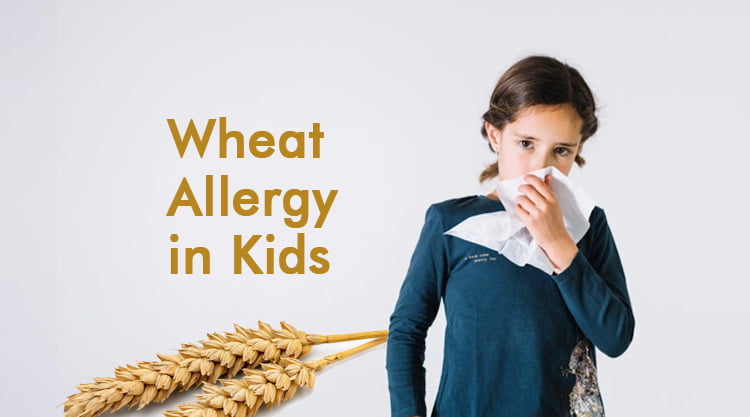
Wheat allergy in kids typically presents itself as a food allergy. Most food allergies are described as abnormal immune responses to certain types of food. The allergic reactions vary in degree, ranging from mild to severe. Food allergies like wheat allergy can also be a result of constant exposure to wheat. Like all other food allergies in children, wheat allergy has an immunoglobulin E and mast cell response. Usually, wheat allergy is limited to the proteins found in its seed. Cases of wheat allergy in children are pretty rare. It is also a misnomer since other components in wheat may cause allergic reactions in kids like prolamins, glutelins and serine protease inhibitors. To date, 27 potential wheat allergens have been identified.
Table of Contents
Wheat Allergy in Kids
Symptoms and Signs of wheat allergy in kids
An allergic reaction mainly occurs within seconds, minutes or after several hours of exposure or consumption of food containing wheat and its other components. Wheat allergy is not to be confused with food intolerance, food poisoning or respiratory allergies. Symptoms vary from person to person. The most common symptoms and signs of an allergic reaction involve:
- Eczema
- Hives
- Irritation and Itchiness
- Swelling of the tongue or throat
- Skin Rashes
- Breathing Problems
- Nausea
- Angioedema i.e tissue inflammation
- Hay fever
- Asthma
- Abdominal Cramps
- Vomiting and Nausea
- Nasal Congestion
- Anaphylaxis
Other symptoms and signs of wheat allergy in kids that are rare includes:
- Anxiety
- Chest Pain
- Unexplained Cough
- Dizziness
- Headaches
- Mood Swings
- Irritable Bowel Syndrome or Diarrhea
- Joint and Muscle Aches
- Psoriasis
- Palpitations
Anaphylaxis
Anaphylactic shocks occur when a reaction is severe. Repeated exposure or consumption of wheat can worsen conditions. Usually, one expects the allergy to subside in children as they grow older.
Anaphylaxis can be life-threatening. It is a serious allergic reaction. Its average onset is 5 to 30 minutes. The common areas affected include 80 to 90% of the body’s skin, respiratory system, gastrointestinal system, heart, central nervous system and vasculature.
The most common symptoms are itchiness, hives, swelling of tongue & conjunctiva, tissue affliction, burning sensation on the skin, runny nose, chest pain, low blood pressure, palpitations, vomiting, anxiety, losing consciousness and others. In many instances, the skin starts turning blue because of the lack of oxygen.
Wheat-dependent exercise-induced anaphylaxis (WDEIA) is rare in children. It typically occurs 1 to 4 hours after consuming wheat ingested food. It is best for children to refrain from exercise or physical activity for 4 to 6 hours after wheat ingestion or just avoid consuming wheat.
Diagnosis is usually made on the basis of a kid’s medical history, skin testing, basophil activation test, exercise challenge test and determination of wheat specific IgA serum antibodies.
Recommended reading: Homeopathic Medication for Ulcerative Colitis
Difference Between Wheat Allergy and Celiac Disease
It is important to differentiate between wheat allergy and celiac disease. As the symptoms overlap, many confuse an allergic reaction with celiac disease.
Wheat allergy in kids occurs when their body produces antibodies to proteins in wheat, like albumins and globulins whereas; celiac disease is a long-term autoimmune disorder. The disease primarily affects the small intestine due to which individuals develop intolerance to gluten. Gluten is present in barley, wheat and rice. It is the causative agent of celiac disease, unlike other wheat allergens. Classic symptoms of celiac disease include gastrointestinal problems such as malabsorption, chronic diarrhoea and low appetite. Among children failure to grow normally and digest food are common symptoms. In children, the symptoms are observed between 6 months and 2 years of age. However, one can develop celiac disease at any age. Celiac disease is also said to be occurring in children who are genetically predisposed. The specific distinction between the disease and wheat allergy is that the former involves permanent intolerance to gluten proteins and the latter is much more rare and varied.
Causes of Wheat Allergy
There are 4 major types of seed-based proteins of wheat. These are albumins, prolamins, globulins and glutelins. Wheat proteins like gliadins and glutelins together called glutenins from the classic protein group called glutens. Glutens are responsible for causing celiac disease and gluten allergy while sensitivity to other proteins become the cause of wheat allergy.
Recommended reading: Long-Lasting Immunity
Sources of Wheat Proteins
The most common and obvious sources of wheat proteins are whole grains, flour, bread, buns and related products. In some cosmetics and bath products, wheat proteins are present. Other common sources of wheat proteins are listed below:
- Bread Crumbs
- Cereals or cereal extracts
- Bakery Products like cakes, cookies, biscuits, muffins, doughnuts, bagels etc.
- Soy Sauce
- Non-vegetarian food items and dishes like hotdogs, pizzas, patties, rolls etc.
- Pasta, Couscous
- Spelt
- Cracker Meal
- Gelatinized Starch
- Dairy Products like Ice-cream
- Baking Coagulates
- Pastry Products
- Bread or Wheat Flour
- Wheat Gluten
- Barley, Rye, Oats, Maize, Corn
- Imitation Seafood
- Vegetable Gum
- Natural Flavours
- Soybeans
- Hydrolysed Vegetable Protein
- Certain Detergents
- Modified Food Starch
Diagnosis
Just like any other food allergy, wheat allergy is diagnosed on the basis of the medical history and family history of a child. Diagnostic tests like skin prick test, blood tests determining food-specific IgA antibodies, oral food challenge, elimination diet, Radioallergosorbent testing (RAST), patch testing, medication and use of drugs like antihistamines, epinephrine and others are used to diagnose and treat wheat allergy.
Recommended reading: Best Treatment for Migraine Headaches
Treatment and Prevention
Prevention and treatment involve both medical and personal care. One needs to be cautious with what one consumes and have wheat-free food. Other ways of managing wheat allergy in kids involve:
- Eliminating food containing wheat
- Having or providing a gluten-free diet
- Avoid wheat consumption before exercise or play.
- Being aware of the food products to have.
- Wearing masks to prevent inhalation of wheat allergens or germs.
- Read the labels on food products or the list of ingredients.
- Keep others informed of the child’s condition so that they can be cautious around your child or help out during an emergency.
- Dine outside carefully.
- Maintain a healthy lifestyle.
- Consult a nutritionist who can provide guidance for making dietary changes for kids.
- Make a list of food allowed, for your child to remember.
- Homeopathic Treatment
Homeopathic Medicines for Wheat Allergy
Homeopathic treatment has also proved effective in treating wheat allergy in kids. The medicines help to regulate and control the symptoms, preventing them to escalate. Medicines are available according to the symptoms largely visible during an allergic reaction. Some of these effective homeopathic medicines prescribed to treat wheat allergy in kids are:
- Allium Cepa
- Colocynthis
- China Officinalis
- Carbo Veg & Lycopodium
- Apis Mellifica
Alternative Food
Kids who have wheat allergies should opt for alternative cereals and food items. Triticeae is such an alternative. These are gluten-free oats devoid of wheat, barley and rye. They are also a healthy source of fibre. In certain cases, one can also have rye bread, buckwheat, millet flour which is wheat-free, cornmeal, flaxseed meal, quinoa flour, tapioca starch and others.
Consumption of alternative grains must be individualised. It should be in accordance with the child’s tolerance level. Alternative flours like vegetables, legumes, nuts, seed or grains, improves the overall nutritional value of a child’s restrictive diet. Varieties of such wheat-free flours are available in the market. Those sensitive to gluten can opt for gluten-free food items widely available in the market. Always check the ingredient lists and labels on food products before purchase.
Risk Factors
Factors that make children susceptible to developing a wheat allergy are as follows:
- Genetic Predisposition– If parents or anyone in the family is allergic to certain types of food or other allergies like asthma, then the child may inherit it.
- Age– Toddlers and those in their early or middle childhood have a sensitive immune system or digestive system. A child as small as 2 months old may be allergic to wheat products. Most children get rid of such allergies as they reach the age of 16 or much earlier.
When To See A Doctor?
A doctor must be consulted immediately in the following situations:
- Emergency due to respiratory problems like shortness of breath, rapid heart rate
- Swelling of the mouth, throat and face.
- Continuous or frequent coughing.
- Chest pain and nausea.
- Vomiting and Diarrhoea.
- Losing Consciousness.
You may also call for emergency services in case of severe allergic reactions.
Conclusion
According to a recent scientific study, wheat could be tolerated by 59% of 4-year-old, 69% of 6 years old, 84% of 10 years old and 96% of 16 years old children. Thus, it can be concluded that most kids having wheat allergy become tolerant to wheat by adolescence. Only those sensitive to gliadin have increased rate of having asthma. About 64% of children who are gliadin IgE positive are susceptible to develop asthma whereas 21% of kids having negative IgE are unlikely to have asthma. According to another study 65% of 12-year-old kids get cured of wheat allergy. Those having higher rate of IgE levels are at the risk of having the allergy for the long term. Nonetheless, both studies confirm that children get rid of wheat allergy by adolescence. In addition, early diagnosis, proper treatment, maintenance of food habits and a healthy lifestyle can surely cure children with wheat allergy and other associated allergies, without the risk of having a relapse.




